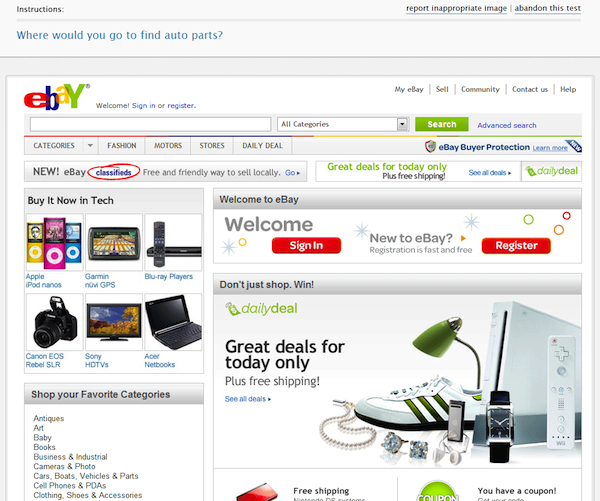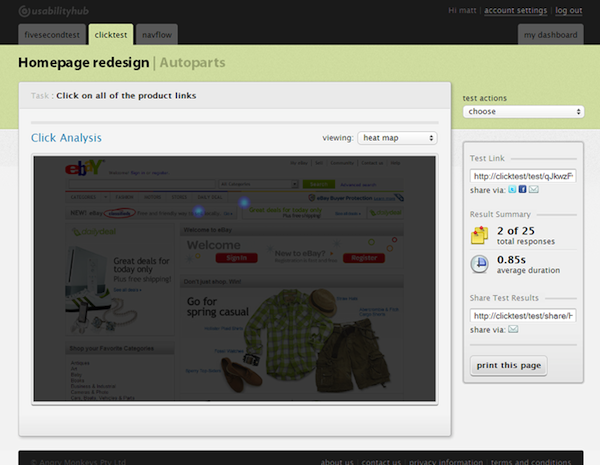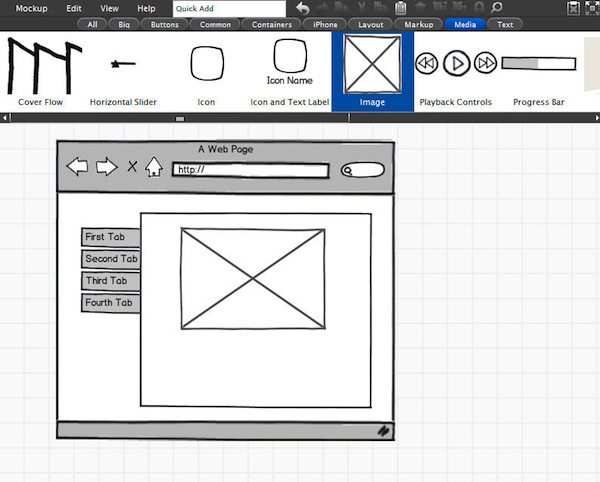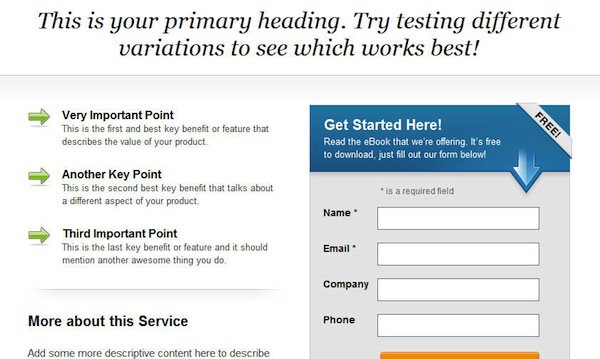A great landing page can easily increase conversion rates between 100 and 300 percent. The process to getting a great landing page is deceptively simple and endlessly iterative: analyze, design, launch, test, repeat.
Marketers across the spectrum of experience face similar challenges. Seasoned marketers hit diminishing returns while novice testers struggle with where to start.
These seven low cost or free tools will help you find fresh ideas for testing and make it easier to get those ideas into market more quickly. You can try them all for a grand total of $157.
ClickTest
Analytics answers the question “Where do users actually click?” But, what about the question “Where do users want to click?”
It’s a seemingly simple question that can reveal a lot about how well your two-dimensional image propels people into your site and what is perceived as the most prominent part of your design. These subtle cues keep visitors happy and exploring.
The ClickTest displays an image you upload, a mockup or jpeg of your current site, for 5 seconds while testers click according to instructions you give, for example “Click on the link where you would go to find sweaters”.

The results are compiled into a heatmap:

Price: Free (if you take tests), $20/month for the least expensive plan
UserTesting.com
Even the best of marketers can be blind to obvious problems on their site. It’s a byproduct of being too familiar with what you sell, the words you use and the way you present your brand.
Qualitative research can be incredibly eye opening and often exposes conversion rate killers that you didn’t know you had.
UserTesting.com offers remote usability testing. You set the URL, tasks they have to complete and questions to answer at the end:

The most useful feature is the built in panel of potential testers that UserTesting will automatically recruit from, limited to your preferences for gender, age, household income, country, and level of web experience. If you have more time or a more specific testing need, you can also recruit from your own customers.
Results come back in about 2 hours as videos, narrated by the testers as they try to work their way through the tasks and questions you’ve given them:

Pricing: $39/test or $29 for your first order when you order at least three tests
Concept Feedback
One of the downsides of user research is that they identify problems, but they aren’t always accompanied by suggestions on how to fix them.
An expert voice can often be the perfect bridge between knowing the problem and identifying the best possible solution.
Enter Concept Feedback: a community of online professionals who will review new designs or concepts and provide detailed feedback. It’s a quick and relatively inexpensive way to get both an outside perspective and a list of actionable recommendations.
You get a marked up version of the creative you submit (live URL or image) marked up with notes:

The summary document is a good record and works for distributing among larger teams and stakeholders:

Price: $99 per expert review
Google Analytics – In-Page Analytics
If there are multiple links on your landing page, such as a category page, it’s a good idea to analyze where visitors click next after they land.
I like both the Navigation Summary and In-Page Analytics reports in Google Analytics, but the below the fold metrics and visual presentation make it easier to find and interpret trends:

Are users clicking the most prominent link? Are your key points getting buried below more popular links?
When a landing page has multiple possible next steps, I’ve found success testing versions that vary the location and emphasis of various links. Using the in-page analytics, try versions that:
- Give more prominence to popular, secondary links
- Use more obvious calls-to-action for key links, such as buttons and imagery
- Remove distractions and add white space around key links
In-Page Analytics is under the Content menu in Google Analytics
Pricing: Free with Google Analytics
Balsamiq
If you’re creating a brand new landing page, a wireframe is a necessity. Pencil and paper is the simplest method, but Balsamiq makes creating wireframes almost as simple and much easier to edit and share.
The app has a PowerPoint-like drag-and-drop interface with a set of common images used in wireframing: browser windows, image placeholders, buttons and so on. Balsamiq requires no design skills, so it’s very marketer friendly.

Balsamiq comes in both web and desktop version. Functionally, there is no difference unless you’re without an Internet connection.
Coworkers don’t need a copy of Balsamiq to share.
Pricing: $79 for the desktop version (which has a 7 day free trial, just download the program) or $12/month for the least expensive web version plan
Notable
The process of moving from wireframe to design is almost always a team exercise between marketing, designers, and other team members. Gathering, acting on, and responding to everyone’s feedback can be tedious.
To make it simpler when I worked on the site redesign for ClickEquations, I used Notable. It’s a tool to mark up any web based interface and share notes with various team members by drawing boxes and adding notes:

The real benefit is that you can share the notes with team members no matter where they are (great for traveling execs and agencies) and everyone can add and respond to comments:

Pricing: $19+/month, depending on the plan
Unbounce
Every marketer knows how hard it is to get tech resources to focus on your project. It’s often the difference between getting a new landing page out next week vs. next month (or worse, next quarter).
Unbounce is targeted more towards small businesses who want to create landing pages using their library of templates. It’s a great way to deploy landing pages when you don’t have large creative or development resources.

I use it as a place to host my landing pages, which I had created as templates. New variations are easy to tweak the duplicate function and simple to test with the built in A/B testing with statistical significance.
Pricing: Free plan to start and $50/month for the basic plan.
The Best $157 You Can Spend on a Landing Page Makeover
A single landing page that increases conversion rate a modest 20 percent would pay for your investment immediately and for months to come. It has a multiplicative effect on your paid search campaign as you can bid more aggressively and shut out competitors you wouldn’t normally be able to challenge.
What cheap or free tools would you add to the list?










